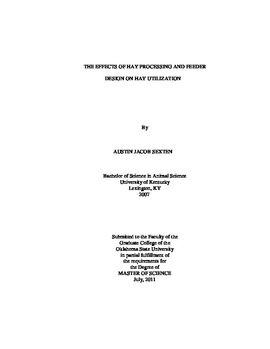| dc.contributor.author | Sexten, Austin | |
| dc.date.accessioned | 2014-04-15T20:13:06Z | |
| dc.date.available | 2014-04-15T20:13:06Z | |
| dc.date.issued | 2011-07-01 | |
| dc.identifier.uri | https://hdl.handle.net/11244/8860 | |
| dc.description.abstract | Four experiments evaluated the effects of hay processing, bale feeder type and supplementation on hay utilization of beef cattle. Experiment 1used 64 crossbred gestating beef cows with two levels of hay processing (long stemmed [LONG] and pre-cut [PCUT]) and two hay feeders (conventional ring feeder [RING] and cone [CONE]). LONG hay had less waste than PCUT (P = 0.003). CONE feeders wasted less hay than RING feeders (P = 0.0002). DMI was not affected by treatments. The second experiment utilized 96 crossbred, weaned calves in assessing the effect of hay processing on post weaning performance. No practical differences were found (P = 0.65). In the third experiment, cow/calf pairs were used to evaluate the effect of hay type on hay utilization. LONG hay wasted less than PCUT (P = 0.03). DMI was not affected by treatment (P = 0.66). Finally the effects of feeder type and supplemental monensin (MON) on hay utilization in beef cows was evaluated using 56 crossbred beef cows in a split-plot with a completely randomized design with supplement as the main unit and a feeder design as the subunit. The main unit included two supplement treatments, while the subunit included four hay feeder designs. Supplement treatments included a 36% CP cottonseed meal based pellet with 0 (CONT; control) or 200 mg/head of MON, fed at a rate of 1.36 kg/ head daily. Feeder treatments included a conventional open bottomed steel ring (OBSR), a sheeted bottomed steel ring (RING), a polyethylene pipe ring (POLY), and a modified cone feeder (MODC). Hay waste was affected by feeder design (P < 0.01). Supplement did not affect hay waste (P = 0.81). DMI was not affected by supplement (P = 0.45) but trended to differ among feeder types (P = 0.12). Supplemental MON improved cow performance (P < 0.05) and apparent digestibility (P < 0.05). The results of these experiments illustrate the importance of bale feeder design, hay processing, and supplementation on a cow/calf operation's profit potential considering that nutritional costs account for 40 to 60% of the annual budget. | |
| dc.format | application/pdf | |
| dc.language | en_US | |
| dc.publisher | Oklahoma State University | |
| dc.rights | Copyright is held by the author who has granted the Oklahoma State University Library the non-exclusive right to share this material in its institutional repository. Contact Digital Library Services at lib-dls@okstate.edu or 405-744-9161 for the permission policy on the use, reproduction or distribution of this material. | |
| dc.title | Effects of Hay Processing and Feeder Design on Hay Utilization | |
| dc.type | text | |
| osu.filename | Sexten_okstate_0664M_11645.pdf | |
| osu.college | Agricultural Sciences and Natural Resources | |
| osu.accesstype | Open Access | |
| dc.description.department | Department of Animal Science | |
| dc.type.genre | Thesis | |
| dc.subject.keywords | beef cattle | |
| dc.subject.keywords | hay feeder | |
| dc.subject.keywords | hay processing | |
| dc.subject.keywords | hay waste | |
| dc.subject.keywords | monensin | |
| dc.subject.keywords | supplementation | |
